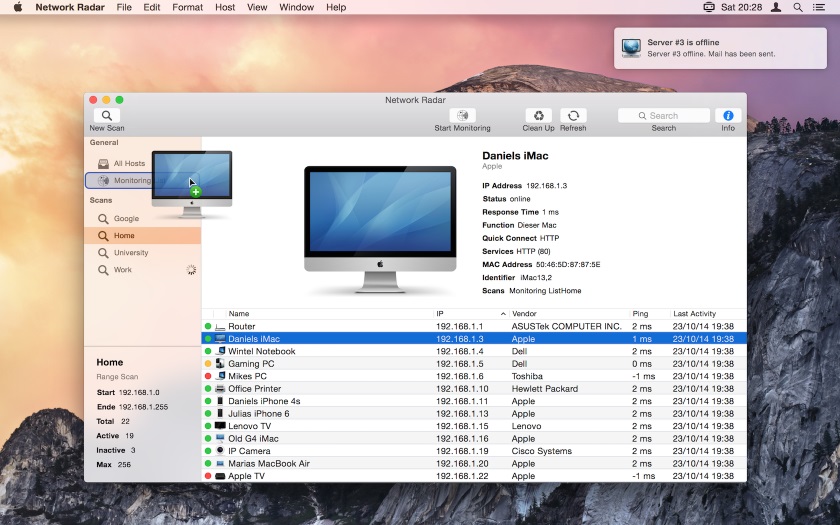

- NETWORK RADAR SIMILAR WINDOWS DRIVERS
- NETWORK RADAR SIMILAR WINDOWS SOFTWARE
- NETWORK RADAR SIMILAR WINDOWS FREE
Incompatible GPU drivers – Another reason why you might see this error is a scenario in which you recently upgraded to Windows 11 from an older Windows version and you’re still using the old GPU drivers that we’re migrated over. NETWORK RADAR SIMILAR WINDOWS FREE
If the freezing happens while your system tries to free up VRAM, you can fix the problem entirely by forcing your Windows 11 to work with a bigger paging file.
Insufficient VRAM – In case you are only working with 4 GB of RAM, issues of this kind can also be encountered whenever your system has to move temporary data to your virtual memory because RAM is already full. In this case, you can resolve the freezes entirely by bringing your screen resolution down. Unsustainable resolution – As it turns out, you can expect to face this type of issue on Windows 11 if you’re using a low-end GPU that’s not capable enough to handle the resolution you’re trying to enforce during resource-intensive tasks. But with Gopher, the Web also gets a major lucky break: the University of Minnesota begins charging for Gopher server licenses in 1993, literally the same spring the Web becomes officially public domain – and free. Two other rival standards, Lynx and Viola, have conveniently converted themselves into Web browsers. The Web pulls ahead partly by incorporating the ability to read Gopher pages this is the same absorption strategy it had employed previously when it added support for WAIS and others. By 1993, the gopher developers are planning to add hyperlinks and even virtual reality features. Developed by Mark McCahill, Paul Lindner and Farhad Anklesaria from a Campus-Wide Information Service, Gopher is named both for the University of Minnosota mascot, and after “go for” meaning fetch. Educational institutions embrace Gopher, as do the U.S. Gopher, which organizes content in folders rather than clickable links, grows faster than the Web in the early ‘90s and is its most direct Internet competitor. Gore famously calls it the “information superhighway.” When it is funded in 1991, the Act creates the National Information Infrastructure, which promotes and funds over $600 million worth of various networking initiatives. At the instigation of computer pioneers, Senator Al Gore begins working in 1987 on what will become his High Performance Computing and Communication Act. government support from the National Science Foundation’s NSFNET and other sources. NETWORK RADAR SIMILAR WINDOWS SOFTWARE
In hindsight, the Internet has several key advantages, from a growing community of enthusiasts churning out working software and hardware, to free distribution with the UNIX operating system, to being built in to common hardware like Cisco routers.īut the decisive factor? Probably money-especially U.S. By 1992 the Internet will have emerged as the new global standard, linking a million computers. But in the meantime the Internet has quietly grown to 100,000 host machines, each with multiple users. As late as 1989, even insiders are betting against it – OSI is the official favorite for the future of internetworking, or connecting networks together.

In 1977 Cerf and Kahn will link the three networks and prove the efficacy of their TCP/IP protocol in a dramatic round-the-world transmission from a moving vehicle, the SRI Packet Radio Research van.Īt its official 1983 launch, the Internet had been a modest experimental network of networks owned by the U.S. ARPA has a practical need to link its original ARPAnet with its newer networks like the Packet Radio Network (PRNET) and Satellite Network (SATNET). Both these efforts will influence the development of ARPA’s TCP/IP internetworking protocol, first sketched out in 1973 by Vint Cerf and Bob Kahn. Xerox PARC begins linking Ethernets with other networks using its PUP (PARC Universal Packet) protocol the same year. So, the next challenge has been creating “networks of networks,” a process called internetworking or internetting.įrance’s CYCLADES and Britain’s NPL network are experimenting with internetworking by 1973 with the European Informatics Network (EIN). But different kinds of networks couldn’t link to each other, limiting the size of online communities. Early networks successfully connected computers.






 0 kommentar(er)
0 kommentar(er)
